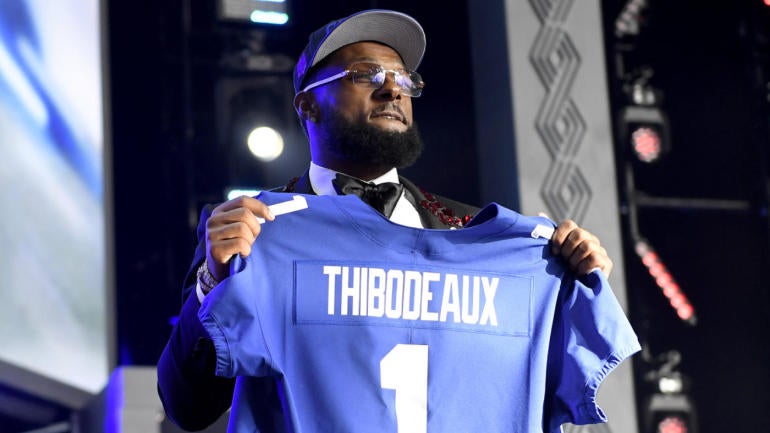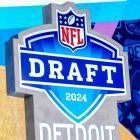
It was a return to business as usual last year with the timing of rookie contracts after the pace of signings slowed considerably in 2020 because of the coronavirus pandemic altering the offseason schedule. There wasn't the same urgency by teams in 2020 without rookie minicamps being held at team facilities during the first two weekends following the NFL Draft and the cancellation of the seven week in-person rookie development program held afterwards.
Ordinarily, at least a quarter of the draftees sign contracts within two weeks of the draft's completion. The removal of the COVID-19 protocols implemented in 2020 ensures normalcy will continue this year.
Here's a look at the deals a select group of first round picks are expected to sign. An explanation of how the rookie wage scale operates as well as a discussion highlighting important considerations or issues relating to the first-round contracts follows.
| Pick | Team | 2022 Salary Cap Number | Signing Bonus | 4 Year Total | ||
|---|---|---|---|---|---|---|
| 1 | Travon Walker | Jaguars | $6,795,022 | $24,360,088 | $37,372,621 | |
| 2 | Aidan Hutchinson | Lions | $6,493,343 | $23,153,372 | $35,717,386 | |
| 3 | Derek Stingley, Jr. | Texans | $6,301,366 | $22,385,464 | $34,657,513 | |
| 4 | Ahmad Gardner | Jets | $6,081,963 | $21,507,852 | $33,450,797 | |
| 5 | Kayvon Thibodeaux | Giants | $5,698,007 | $19,972,028 | $31,339,038 | |
| 6 | Ikem Ekwonu | Panthers | $5,012,373 | $17,229,492 | $27,568,051 | |
| 7 | Evan Neal | Giants | $4,463,865 | $15,035,460 | $24,551,257 | |
| 8 | Drake London | Falcons | $3,915,358 | $12,841,432 | $21,534,469 | |
| 9 | Charles Cross | Seahawks | $3,887,932 | $12,731,728 | $21,383,626 | |
| 10 | Garrett Wilson | Jets | $3,737,092 | $12,128,368 | $20,554,006 | |
| 11 | Chris Olave | Saints | $3,503,977 | $11,195,908 | $19,271,873 | |
| 12 | Jameson Williams | Lions | $3,174,871 | $9,879,484 | $17,461,790 | |
| 13 | Jordan Davis | Eagles | $3,092,596 | $9,550,384 | $17,009,278 | |
| 14 | Kyle Hamilton | Ravens | $2,955,470 | $9,001,880 | $16,255,085 | |
| 20 | Kenny Pickett | Steelers | $2,557,801 | $7,411,204 | $14,067,905 | |
| 22 | Quay Walker | Packers | $2,516,662 | $7,246,648 | $13,841,641 | |
| 28 | Devonte Wyatt | Packers | $2,338,397 | $6,533,588 | $12,861,183 | |
| 32 | Lewis Cine | Vikings | $2,089,846 | $5,539,384 | $11,494,153 |
How the rookie wage scale operates
The rookie wage scale is essentially a salary cap within the overall salary cap. The increases in rookie salaries from one draft class to another are primarily tied to growth of the salary cap. Signing bonuses are going up one percent for the second straight year despite a $25.7 million increase in the salary cap. This can be attributed to the NFL and NFLPA agreeing in 2020 to borrow money from future rookie wage scales to keep 2021 rookie deals from decreasing because of the 2020 revenue shortfall caused by COVID-19.
There's a league wide limit on the total amount of compensation for rookies with specific salary parameters for each draft slot. Teams have maximum and minimum amounts that can be spent on their picks based on draft position.
All contracts for draft choices are four years. Each pick in the draft has a salary floor and ceiling in the first year and over the four years of the contract. There are very few negotiable items with rookie contracts anymore. The salary components of a deal are restricted to signing bonus, base salary, roster bonus, reporting bonus, workout bonus and select incentives. The type of salary escalators and incentives that used to be responsible for salaries skyrocketing at the top of draft are prohibited under the rookie wage scale. A majority of picks only have signing bonus and base salaries in their deals.
An extremely important aspect of these deals is the first year salary cap number (also known as the rookie pool number) because it helps determine the overall value of a contract. The first year cap number or rookie pool number consists of the player's prorated amount of signing bonus and the rookie minimum base salary, which is $705,000 in 2022.
The maximum annual increase in each of the four years of a deal is 25% of the first year cap number. To illustrate this concept, 2021 third overall pick Trey Lance's cap numbers were limited to a $1,550,239 increase in each year of his deal because his first year cap number was $6,200,956. Since all of these deals have minimum base salaries in the first year, the remainder of the contract is derived within these constraints.
Draft pick contracts can't be renegotiated until the conclusion of a player's third NFL regular season. This means the earliest Lance's deal can be redone is in January 2024.
Teams have an option for a fifth year with first round picks that must be exercised after the third year of the deal. The period for exercising fifth year options begins after a player's third NFL regular season ends (January 10, 2022 with the 2019 first round picks). These options must be picked up prior to May 3.
The new Collective Bargaining Agreement changed how fifth year options operate. The fifth year salary is fully guaranteed when the option is exercised. A player's fourth year base salary becomes fully guaranteed when the option year is picked up if it wasn't already.
The fifth year salaries are no longer strictly tied to where a player was drafted (i.e.; top 10 or outside of top 10). Performance dictates the option year salaries. With two or more Pro Bowl selections on the original ballot during the first three seasons of contracts, the fifth year salary is the franchise tender, which is average of the five highest salaries, for a player's position in the fourth year of his contract. For example, 2019 first overall pick Kyler Murray's fifth year option with the Cardinals for 2023 is the 2022 franchise tender for quarterbacks, which is $29.703 million, because he was selected to the Pro Bowl on the original ballot in his second and third NFL seasons.
One Pro Bowl selection on the original ballot during the first three seasons of deals puts the fifth year salary at the transition tender, which is average of the 10 highest salaries, for a player's position in the fourth year of his contract. Panthers edge rusher Brian Burns and Lions tight end T.J. Hockenson have a 2023 fifth year salary at the 2022 transition tender for their respective positions.
Participating in 75% of offensive or defensive plays, whichever is applicable, in two of the first three seasons of deals or an average of at least 50% playtime in each of their first three seasons sets the fifth year salary at the average of the third through twentieth highest salaries at a player's position. For first round picks that don't fall into any of these three categories, the fifth year salary is the average of the third through twenty-fifth highest salaries at a player's position.
The Proven Performance Escalator which increases the fourth year salary for third through seventh round picks now also applies to second round picks and is more expansive with higher playtime thresholds.
Third through seventh round picks still have a salary escalator for their fourth year based on participating in a minimum of 35% of the offensive or defensive plays, whichever is applicable, in two of the first three seasons of their deals or an average of at least 35% playtime in their first three seasons. The salary equals the original draft round restricted free agent tender in the fourth year. The number is $2.54 million this year. With second round picks, the required playtime is 60% in order for the fourth year salary to be at this level.
The fourth year salary for second through seventh round picks increases to the original draft round restricted free agent tender in that specific year plus $250,000 with at least 55% offensive or defensive playtime in each their first three seasons of the contract. $2.79 million is the number for this year. Fourth year salary will elevate to the second round restricted free agent tender with at least one Pro Bowl selection on the original ballot in the first three years of a rookie deal. The second round restricted free agent tender is $3.986 million this year.
Negotiable items
There are very few negotiable items with rookie contracts anymore. The two primary negotiating issues, particularly at the top of the draft, are the payment schedule of the signing bonus and whether salary guarantees will have offsets. Another important consideration is the language outlining the voiding of salary guarantees.
A majority of rookies didn't sign contracts until the latter part of July as training camp approached before the rookie compensation system was overhauled in the 2011 CBA. In 2010, no player selected in the first two rounds had signed by the Fourth of July. First round picks holding out wasn't unusual either. For example, 2007 first overall pick JaMarcus Russell held out for 47 days before signing with the Raiders. Rookie holdouts are largely a thing of the past.
The Chargers and third overall pick Joey Bosa engaged in the longest contract dispute for an incoming NFL player under the rookie wage scale in 2016. Bosa was the first rookie since 2013 that didn't show up to training camp on time. He missed 31 days before signing his contract.
Linebacker Roquan Smith, 2018's eighth overall pick, missed the first two weeks of training camp because he and his agents objected to language where the Bears had the right to void his guarantees for an ejection or suspension from a game for violating NFL playing rules. A compromise was reached on the number of games in a suspension necessary to trigger voiding.
The Chargers and Bosa weren't disagreeing over the amount of money in his contract because the total value was dictated by the rookie wage scale's constraints. The dispute was largely over the payment schedule of Bosa's signing bonus, the inclusion of roster bonuses and related language if the deal contained offsets. A major concession the Chargers made to Bosa was a better payment schedule than they typically give to players with big signing bonuses.
An offset clause allows a team to reduce the guaranteed money owed to a player when he is released by the amount of his new deal with another team. The player receives his salary from the team that released him in addition to the full salary from his new contract with another club when there isn't an offset (also known as "double dipping").
Agents have essentially lost the battle on offsets. Teams with early first round picks in 2013 were adamant that contracts contain offsets after largely conceding the issue the previous year. As a compromise for top 10 picks, most teams structure deals with minimum base salaries in the final three years where the remainder of a player's salary is in annual fully guaranteed third or fifth day of training camp roster bonuses.
Nearly every team besides the Jaguars and the Rams, who don't have a first round pick this year, require offsets with salary guarantees for draft picks, including those selected in the top 10. In addition to 2021 first overall pick Trevor Lawrence, the Jaguars didn't necessitate offsets with 25th overall pick Travis Etienne's guarantees. Based on past practices, first overall pick Travon Walker's contract with the Jaguars shouldn't contain offsets.
Lawrence was able to get the Jaguars to give him these training camp roster bonuses even though there aren't any offsets with his guarantees. It was the first time a player had gotten both under the rookie wage scale. Walker will surely push for the same treatment. It remains to be seen whether the Jaguars will try to make a distinction between the two players with the roster bonuses because Lawrence is a quarterback.
More players throughout the first round may push for these training camp roster bonuses with base salary no longer paid over the course of the 18 week regular season. Beginning in 2021, base salary was paid over a period of 36 weeks (twice the number of regular season weeks).
Large signing bonuses in NFL contracts aren't typically paid in one lump sum. This is a long accepted practice in the NFL. Signing bonuses for top draft picks have typically been paid in two to four installments.
Lump sum payments are starting to become more accepted at the top of the first round. The Jaguars made a big departure from their customary signing bonus payment schedule with Lawrence. His entire $24,118,900 signing bonus was payable within 15 business days of signing. The Jaguars had deferred half of signing bonus until the end of the following March with most of their prior top 10 picks. Walker is likely going to try to hold the Jaguars to this new precedent, just like with the training camp roster bonuses.
Zach Wilson and Trey Lance, last year's second and third overall picks, got their $22,924,132 and $22,163,824 signing bonuses paid in a lump sum respectively by the Jets and 49ers. Receipt of the money was in a similar timeframe as Lawrence.
Previously, 2018 third overall pick Sam Darnold's entire $20,078,324 signing bonus was payable by the Jets within 15 days of inking his deal. 2019 second overall pick Nick Bosa got a lump sum payment from the 49ers. His $22,421,356 signing bonus was payable in the same timeframe as Darnold's. 2020 first overall pick Joe Burrow and second overall pick Chase Young got their respective $23,880,100 and $22,697,160 signing bonuses from the Bengals and Commanders in a lump sum. Burrow's was paid within 15 days of signing. Young got his within 30 days.
Signing bonus payment could be a sticking point in the second overall pick Aidan Hutchinson's negotiations with the Lions. The last three players selected second overall (Wilson, Young and Bosa) have gotten lump sum signing bonus payments. 2021 seventh overall pick Penei Sewell got half of his $14,886,596 signing bonus from the Lions within 30 days of executing his contract. The Lions paid him the other half right before the 2021 regular season started early last September.
The entire contracts of the first 28 picks of the first round were fully guaranteed in 2021, which was two more players than in 2020. The deals for the final four picks of the first round were guaranteed for the first three years. A decreasing portion of the fourth year base salary has been guaranteed as the picks progress. 96% of 2021 29th overall pick Eric Stokes' fourth year salary in 2024 is fully guaranteed while 78% of 2021 32nd overall pick Joe Tryon-Shoyinka's is fully guaranteed.





















